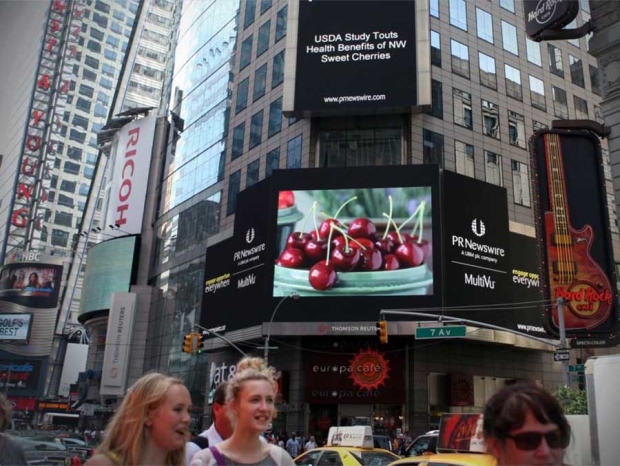With the industry running full tilt into apple harvest … the team at the Northwest Cherry Growers is putting together the post season pieces of this year’s sweet cherry harvest. Final numbers are still being compiled but it looks like the 2013 crop is going to come at the 14.6 million 20 lb. equivalent boxes. Certainly, this crop was much shorter than all of us hoped … it will still be in the top 5 largest crops we have harvested out of the Northwest.
Again this year, we suffered through numerous rain events … on a crop that started out 30% below what we harvested in 2013. As the rain events piled up … the crop volume continued to plummet and as we came into the 4th of July holiday … there were retail and export buyers clamoring for any fruit they could get their hands on. Quite simply … there was not close to enough fruit to go around … and many consumers missed having cherries during their 4th of July barbeques.
Conversely, there was plenty of media hitting the airwaves during this period. All of it “earned” through a story board that was centered on the health benefits surrounding our cherries. As it turned out … we would have been better served to have the media storm on cherries hit later in July when cherry volumes finally increased. Unfortunately, when it comes to earned media … we have little say when our health stories hit television, radio, magazines, newspapers and the every important world of food and health bloggers. To clarify, “earned media” refers to favorable publicity gained through promotional efforts other than paid advertising, as opposed to paid media, which refers to publicity gained through paid advertising. Earned media often refers specifically to publicity gained through editorial influence, whereas social media refers to publicity gained through grassroots action, particularly on the Internet.
The media may include any mass media outlets, such as newspaper, television, radio, and the Internet, and may include a variety of formats, such as news articles or shows, letters to the editor, editorials, and polls on television and the Internet. Critically, earned media cannot be bought or owned, it can only be gained organically, hence the term ‘earned’. Today, a national television media campaign runs close to $500,000 per each 30 second ad run. With Northwest Cherry industry’s limited generic promotion budgets … we could run a total of 5 ads before our total budget was drained. Thus, a mass paid advertising push is not realistic or feasible. Therefore, we rely on trying to move the media balance with less costly yet consumer important media massages … that might be of interest to any and all media channels.
Here at the Northwest Cherry growers we do implement a limited amount of paid media … more in the international markets than in the domestic market. By design we aim to create discussion within consumer groups by targeting influential content creators who themselves lead conversations through print, digital and social media.
This helps pull our story into a home, rather than join the ranks of those that force their way in. However, our growers have paid for numerous studies looking into the health benefits of sweet cherries, and all options should be considered to get this data out into the world in a digestible format! This year we received some amazing results with our messaging, getting attention across the globe and at some of the highest levels.
As stated, the timing is always the challenge, especially when submission deadlines have to be observed. Aiming for a launch following the California crop but at the very earliest volume stages for the Northwest season is always a dart throw, and this year that dart landed in mid-June. In those first few weeks post-launch during the second half of June, we received placements ranging from the publishing giants of The Wall Street Journal and Reuters to media sites like FoxNews.com, Huffington Post and even some international posts from as far away as Yahoo! Singapore!
Beyond the consumer, health and the grocery channels, the impact of the information interested the business world as well, as evidenced by the 42 business journals across the country that picked up our press release and ran with it. In today’s media world, text is nothing without photos or video to help drive it. We included both in our releases and outreach.
As a result, our sweet cherry health messaging was broadcast across 146 television stations from WFLX in West Palm Beach to KNDO right here in Central Washington. It was also streamed across the web to 209 media sites, including CNN.com, which featured the video along with the text release. In early July, the our media blitz peaked when our story ran several times over two days … live in New York City’s Times Square.

Though small in budget, our programs aim to build on one another. To amplify the noise created by our health messages, NWC interwove programs to promote each other and carry the message throughout the season. For example, a produced morning show segment called The Daily Buzz used the new health information to promote sweet cherries as a great 4th of July food for parties and get-togethers in the week leading up to the holiday.
They reach just shy of 2-million shoppers per broadcast across 163 U.S. DMAs. The national Tree-to-Table program in mid-July also focused on health, as each of the 50 participating chefs and writers across the country were asked to highlight a healthy menu option featuring cherries. Among others, AOL Food promoted the event with messaging to it’s over 26 million readers. Fortunately, by then more cherries were available on the shelves.
Now we just need to it again in 2014.

Leave A Comment